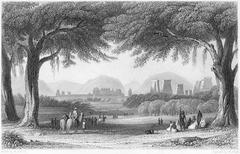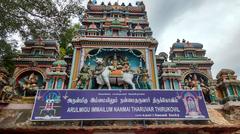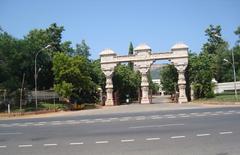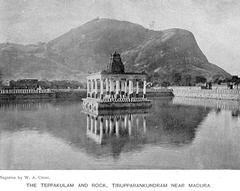
Guide to Visiting Tirumalai Nayak Palace, Madurai, India
Date: 31/07/2024
Introduction
Located in the heart of Madurai, India, the Thirumalai Nayak Palace stands as a testament to the architectural and cultural prowess of the Nayak dynasty. Constructed in 1636 by King Thirumalai Nayak, this grand palace is an exemplary blend of Indo-Islamic, Dravidian, and European styles, reflecting the rich heritage of the region. The palace, originally sprawling over a much larger area, now remains a fraction of its former glory but continues to captivate visitors with its majestic corridors, towering pillars, and intricate stucco work (Polkajunction, Thrilling Travel).
The Nayak dynasty, which ruled Madurai from 1545 CE to the 1740s, was instrumental in fostering a thriving cultural and architectural landscape. King Thirumalai Nayak, one of the most notable rulers of this dynasty, envisioned the palace as the grandest in South India. His efforts resulted in a structure that not only served as the royal residence and administrative center but also as a hub of cultural activities and festivals (Culture and Heritage).
Over the centuries, the palace experienced periods of decline, particularly during the reign of Thirumalai Nayak’s grandson, who demolished parts of the original structure. However, restoration efforts in the late 19th century and subsequent maintenance by Madurai Tourism authorities have preserved its grandeur, making it a significant tourist attraction today (Culture and Heritage, Thrilling Travel).
This comprehensive guide aims to provide detailed information on the historical significance, architectural beauty, visiting hours, ticket prices, and practical tips for visiting the Thirumalai Nayak Palace. Whether you’re a history enthusiast, architecture admirer, or a curious traveler, this guide will help you make the most of your visit to this magnificent palace.
Contents
- Explore the Thirumalai Nayak Palace
- History of Thirumalai Nayak Palace
- The Nayak Dynasty and Thirumalai Nayak
- Architectural Grandeur
- Construction and Materials
- Decline and Restoration
- Modern-Day Preservation
- Cultural Significance
- Key Features
- Swarga Vilasam (Celestial Pavilion)
- Ranga Vilasam (Dance Hall)
- Visitor Information
- Visitor Experience
- Light and Sound Show
- Best Time to Visit
- Accessibility
- Ticket Information
- Conclusion
- FAQ Section
Explore the Thirumalai Nayak Palace
History of Thirumalai Nayak Palace
The Nayak Dynasty and Thirumalai Nayak
The Nayak dynasty of Madurai, which ruled from 1545 CE until the 1740s, played a significant role in the region’s history. Thirumalai Nayak, one of the most prominent kings of this dynasty, reigned from 1623 to 1659. He is credited with constructing several monumental structures in and around Madurai, including the grand Thirumalai Nayak Palace, also known as Nayakar Mahal (Polkajunction).
Architectural Grandeur
Thirumalai Nayak envisioned the palace as the grandest in South India. The palace’s architecture is a unique blend of Indo-Islamic and European styles, particularly Italian. The elaborate entablature and rounded pillars are reminiscent of European architecture, while the stuccowork and frescoes reflect Indian heritage (Thrilling Travel). The palace originally covered a much larger area, but what remains today is only a fraction of its former glory.
Construction and Materials
The construction of the palace began around the 1630s. The materials used included a mixture of limestone and eggshell, known as chunnam, which contributed to the palace’s sturdy structure. This construction method is believed to have created a land pit that later became the famous Mariamman Teppakulam pond, where the current Madurai Meenakshi Temple festival of floats takes place (Thrilling Travel).
Decline and Restoration
The palace’s decline began with Thirumalai Nayak’s grandson, who demolished much of the original structure to use its jewels and woodcarvings for his own palace in Tiruchirapalli. The new palace, however, did not match the grandeur of the original. The palace suffered further damage due to various wars and neglect over the years (Polkajunction).
In the late 19th century, the colonial Governor of Madras, Lord Napier, undertook partial restoration of the palace between 1866 and 1872. His efforts were aimed at using the palace as a garrison unit rather than restoring it to its former residential glory (Polkajunction).
Modern-Day Preservation
The palace fell into disrepair again until the Madurai Tourism authorities took over its maintenance. Although there is still much work to be done, the restored sections of the palace are enough to leave visitors in awe. The palace is now a significant tourist attraction, showcasing the architectural brilliance of the Nayak era (Thrilling Travel).
Cultural Significance
The Thirumalai Nayak Palace is not just an architectural marvel but also a testament to Madurai’s rich cultural heritage. The palace’s design reflects the secular and diverse nature of Madurai, often referred to as the “Athens of the East” by colonists due to its well-planned layout (Polkajunction).
Key Features
Swarga Vilasam (Celestial Pavilion)
The central courtyard, known as Swarga Vilasam, was used as the royal court. The high ceilings and painted frescoes of the corridors are particularly noteworthy. The ceilings start with simple mono-colored flower designs and gradually transition to vibrant decor, showcasing the artistic prowess of the era (Thrilling Travel).
Ranga Vilasam (Dance Hall)
The Ranga Vilasam, or dance hall, is another stunning feature of the palace. The hall’s ceilings are adorned with intricate designs that resemble Persian carpets, and the vibrant colors remain striking even today. This hall was used for performances and cultural events during the Nayak period (Thrilling Travel).
Visitor Information
Visitor Experience
Visitors to the Thirumalai Nayak Palace are often struck by the sheer scale and grandeur of the structure. The palace’s towering columns, some measuring 82 feet in height and 19 feet in width, create a sense of awe. The long corridors and vast central courtyard offer a glimpse into the opulence of the Nayak era (Thrilling Travel).
Light and Sound Show
The palace also hosts a light and sound show that narrates its history. However, some visitors find the show less engaging compared to the architectural marvels of the palace itself. The show uses lights to tell the story of the Nayaks and their rise to power, but the narration and effects have received mixed reviews (Thrilling Travel).
Best Time to Visit
Madurai is warm throughout the year, with winters (October to February) being slightly more comfortable. These months are recommended for visiting the palace to avoid the extreme heat of the summer months (Thrilling Travel).
Accessibility
Madurai is well-connected by flights, road, and rail. For those traveling by road from Bangalore, the best route is via NH 44, covering approximately 430 km in around 7 hours. The road conditions are generally excellent, making for a smooth journey (Thrilling Travel).
Ticket Information
The palace is open to visitors from 9 am to 5 pm. The entry fee for the light and sound show is INR 50 for adults. It is advisable to visit during the day to fully appreciate the architectural details and grandeur of the palace (Thrilling Travel).
Conclusion
The Thirumalai Nayak Palace stands as a monument to the architectural and cultural achievements of the Nayak dynasty. Despite the ravages of time and neglect, the palace continues to captivate visitors with its blend of Indo-Islamic and European architectural styles, making it a must-visit destination in Madurai.
FAQ Section
What are the visiting hours of Thirumalai Nayak Palace?
The palace is open to visitors from 9 am to 5 pm.
How much are the tickets for Thirumalai Nayak Palace?
The entry fee for the light and sound show is INR 50 for adults.
What is the best time to visit Thirumalai Nayak Palace?
The best time to visit is from October to February to avoid the extreme heat of summer months.
Call to Action
Plan your visit to the Thirumalai Nayak Palace and explore the architectural marvels of the Nayak era. Download our mobile app Audiala for more travel tips and updates. Don’t forget to check out our other related posts and follow us on social media for more updates!
Summary
The Thirumalai Nayak Palace is not merely a historical monument but a vivid gateway into the rich and opulent past of the Nayak dynasty. Despite the ravages of time and periods of neglect, the palace’s restoration and ongoing preservation efforts ensure that its architectural brilliance remains accessible to visitors. The blend of Indo-Islamic, Dravidian, and European styles in its construction reflects the cultural confluence that Madurai has historically epitomized (Thrilling Travel).
Visitors to the palace are often mesmerized by its grand arches, towering pillars, and intricate stucco work, which serve as a testament to the architectural ingenuity of the Nayak era. The Swarga Vilasam and Ranga Vilasam are particularly noteworthy for their aesthetic and historical significance. The light and sound show further enriches the visitor experience by narrating the palace’s history in a captivating manner (Tripoto).
For those planning a visit, the best time to explore the palace is between October and March, when the weather is pleasant. The palace’s accessibility and the availability of guided tours make it a convenient and enriching experience for all kinds of travelers. Nearby attractions such as the Meenakshi Amman Temple and Gandhi Memorial Museum offer additional insights into the cultural and historical landscape of Madurai (Travelsetu).
In conclusion, the Thirumalai Nayak Palace remains a must-visit destination for anyone seeking to delve into the architectural and cultural heritage of Madurai. Its enduring grandeur and historical significance continue to captivate and inspire, making it a highlight of any visit to this ancient city.




